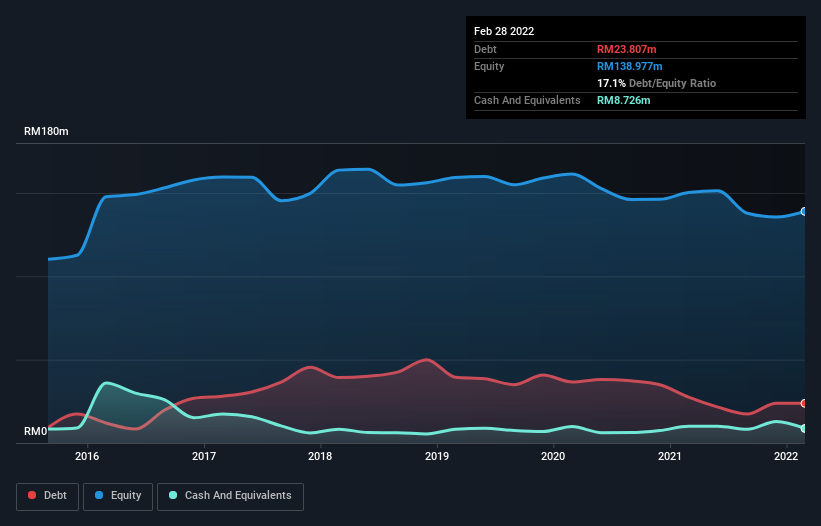Here's Why Sasbadi Holdings Berhad (KLSE:SASBADI) Can Afford Some Debt
David Iben put it well when he said, 'Volatility is not a risk we care about. What we care about is avoiding the permanent loss of capital.' So it seems the smart money knows that debt - which is usually involved in bankruptcies - is a very important factor, when you assess how risky a company is. Importantly, Sasbadi Holdings Berhad (KLSE:SASBADI) does carry debt. But should shareholders be worried about its use of debt?
Why Does Debt Bring Risk?
Debt is a tool to help businesses grow, but if a business is incapable of paying off its lenders, then it exists at their mercy. Part and parcel of capitalism is the process of 'creative destruction' where failed businesses are mercilessly liquidated by their bankers. However, a more usual (but still expensive) situation is where a company must dilute shareholders at a cheap share price simply to get debt under control. Of course, plenty of companies use debt to fund growth, without any negative consequences. The first step when considering a company's debt levels is to consider its cash and debt together.
View our latest analysis for Sasbadi Holdings Berhad
How Much Debt Does Sasbadi Holdings Berhad Carry?
The image below, which you can click on for greater detail, shows that Sasbadi Holdings Berhad had debt of RM23.8m at the end of February 2022, a reduction from RM27.5m over a year. However, because it has a cash reserve of RM8.73m, its net debt is less, at about RM15.1m.

How Strong Is Sasbadi Holdings Berhad's Balance Sheet?
The latest balance sheet data shows that Sasbadi Holdings Berhad had liabilities of RM44.2m due within a year, and liabilities of RM8.43m falling due after that. On the other hand, it had cash of RM8.73m and RM50.0m worth of receivables due within a year. So it actually has RM6.13m more liquid assets than total liabilities.
This surplus suggests that Sasbadi Holdings Berhad has a conservative balance sheet, and could probably eliminate its debt without much difficulty. The balance sheet is clearly the area to focus on when you are analysing debt. But it is Sasbadi Holdings Berhad's earnings that will influence how the balance sheet holds up in the future. So if you're keen to discover more about its earnings, it might be worth checking out this graph of its long term earnings trend.
In the last year Sasbadi Holdings Berhad wasn't profitable at an EBIT level, but managed to grow its revenue by 13%, to RM57m. We usually like to see faster growth from unprofitable companies, but each to their own.
Caveat Emptor
Importantly, Sasbadi Holdings Berhad had an earnings before interest and tax (EBIT) loss over the last year. Its EBIT loss was a whopping RM12m. On a more positive note, the company does have liquid assets, so it has a bit of time to improve its operations before the debt becomes an acute problem. But we'd want to see some positive free cashflow before spending much time on trying to understand the stock. So it seems too risky for our taste. There's no doubt that we learn most about debt from the balance sheet. However, not all investment risk resides within the balance sheet - far from it. To that end, you should learn about the 2 warning signs we've spotted with Sasbadi Holdings Berhad (including 1 which can't be ignored) .
When all is said and done, sometimes its easier to focus on companies that don't even need debt. Readers can access a list of growth stocks with zero net debt 100% free, right now.
New: Manage All Your Stock Portfolios in One Place
We've created the ultimate portfolio companion for stock investors, and it's free.
• Connect an unlimited number of Portfolios and see your total in one currency
• Be alerted to new Warning Signs or Risks via email or mobile
• Track the Fair Value of your stocks
Have feedback on this article? Concerned about the content? Get in touch with us directly. Alternatively, email editorial-team (at) simplywallst.com.
This article by Simply Wall St is general in nature. We provide commentary based on historical data and analyst forecasts only using an unbiased methodology and our articles are not intended to be financial advice. It does not constitute a recommendation to buy or sell any stock, and does not take account of your objectives, or your financial situation. We aim to bring you long-term focused analysis driven by fundamental data. Note that our analysis may not factor in the latest price-sensitive company announcements or qualitative material. Simply Wall St has no position in any stocks mentioned.
About KLSE:SASBADI
Sasbadi Holdings Berhad
An investment holding company, publishes books and educational materials primarily in Malaysia.
Flawless balance sheet and undervalued.
Market Insights
Community Narratives



